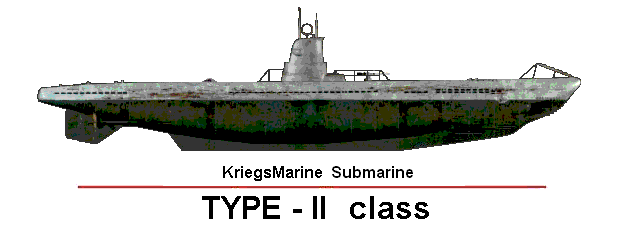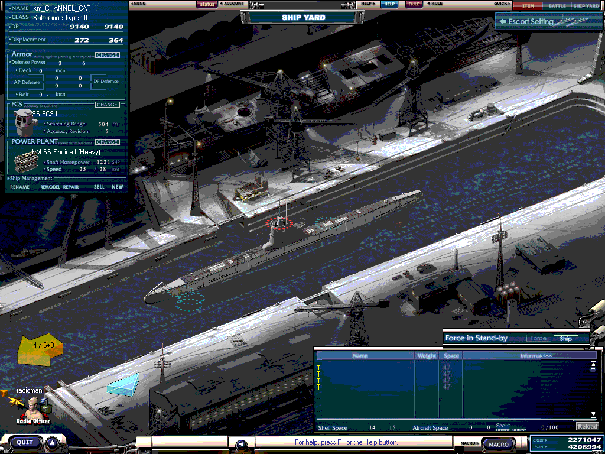The Type II U-boat was designed by Germany as a coastal submarine, modeled after the submarine CV-707, which was designed by Dutch dummy company NV Ingenieurskantoor voor Scheepsbouw den Haag (I.v.S) (set up by Germany after World War I in order to maintain and develop German submarine know-how and to circumvent the limitations set by the Treaty of Versailles) and built in 1933 by the Finnish Crichton-Vulcan shipyard in Turku, Finland. It was too small to undertake sustained operations far away from the home support facilities. Its primary role was found to be in the training schools, preparing new German naval officers for command. It appeared in four sub-types. 
Kreigsmarine Submarines - Type II Class ==========================================================================

Germany was stripped of her U-boats by the Treaty of Versailles at the end of World War I, but in the late 1920s and early 1930s began to rebuild her armed forces. The pace of program accelerated under Adolf Hitler, and the first Type II U-boat was laid down on 11 February 1935. Knowing that the world would see this step towards rearmament, Hitler reached an agreement with Britain to build a navy up to 35% of the size of the Royal Navy in surface vessels, but equal to the British in number of submarines. This agreement was signed on 18 June 1935, and U-1 was commissioned 11 days later.
The defining characteristic of the Type II was its tiny size. Known as the Einbaum ("dugout canoe"), it had the advantages over larger boats of the ability to work in shallow water, diving more quickly, and being more difficult to spot due to the low conning tower. However, it had a shallower maximum depth, short range, and cramped living conditions, and could carry few torpedoes.
The boat had a single hull, with no watertight compartments. There were three torpedo tubes forward (none aft), with space for another two torpedoes inside the pressure hull for reloads. A single 20 mm anti-aircraft gun was provided, but no deck gun was mounted.
Space inside was limited. The two spare torpedoes extended from just behind the torpedo tubes to just in front of the control room, and most of the 24-man crew lived in this forward area around the torpedoes, sharing 12 bunks. Four bunks were also provided aft of the engines for the engine room crew. Cooking and sanitary facilities were basic, and in this environment long patrols were very arduous.
Most Type IIs only saw operational service during the early years of the war, thereafter remaining in training bases. Six were stripped down to just a hull, transported by river and truck to Linz (on the Danube), and reassembled for use in the Black Sea against Soviet Union. (Hitler's Lost Fleet)
In contrast to other German submarine types, few Type IIs were lost. This, of course, reflects their use as training boats, although accidents accounted for several vessels.
These boats were a first step towards re-armament, intended to provide Germany with experience in submarine construction and operation and lay the foundation for larger boats to build upon. Only one of these submarines survives to this day; the prototype CV-707, renamed Vesikko by the Finnish Navy which later bought it.
First launched in June 1935, the Type II were the first U-boats commissioned in German yards after the repudiation of the Versailles Treaty. (Unknown to other nations at that time, Germany had already begun construction for 12 new Type II U-boats as early as 1934). It was not until the signing of the Anglo-German Naval Agreement in February 1935 that construction began to be undertaken publicly. By June 15 1935, the first class of the Type II was launched.
Small and cramped, the Type II were coastal boats intended principally for training, but because of the shortage of available boats, they were later relegated to war duties. With a crew of 25, the boats had limited range and carried enough provisions for three to four weeks, but frequently returned to port after expending their supply of torpedoes.
Due to their small size and heavy rolling on the sea, the Type IIs quickly earned the nickname Dugout Canoes. Although of limited use in the open ocean, some remarkable successes were accomplished early in the war by U-boat aces such as Otto Kretschmer. The Type II also earned the respect and admiration of the crew due to its high maneuverability, rapid diving time and durability. Later in the war, due to the ever increasing need for training new crews, all Type II U-boats were withdrawn from combat duties and assigned to full-time training.
A total of 50 Type II U-boats were built during the war. There are four variants, Type IIA, IIB, IIC and IID.
The Type IIA was a single hull, all welded boat with internal ballast tanks. Compared to the other variants, it had a smaller bridge and could carry the German G7a, G7e torpedoes as well as TM-type torpedo mines. There was a single periscope in the conning tower with serrated net cutters in the bow. The net cutters were adopted from World War 1 boats but were quickly discontinued during World War 2.
The Type IIB was a lengthened version of the Type IIA. Three additional compartments were inserted amidships which were fitted with additional diesel tanks beneath the control room. The range was increased to 1,800 nautical miles at 12 knots. Diving time was also improved to 30 seconds.
The Type IIC was a further lengthened version of the Type IIB with an additional two compartments inserted amidships to accomodate improved radio room facilities and a second periscope. The additional diesel tanks beneath the control room was further enlarged, extending the range to 1,900 nautical miles at 12 knots.
The Type IID had additional saddle tanks fitted to the sides of the external hull. These saddle tanks were used to accomodate additional diesel storage tanks. The diesel oil would float atop the saddle tanks and as the oil is consumed, sea water would gradually fill the tanks to compensate for the positive buoyancy. The range was nearly doubled to 3,450 nautical miles at 12 knots and enabled the Type II to operate around the British Isles. A further development was the propellers were fitted with Kurt nozzles, intended to improve propulsion efficiency.

Unterseeboot 1 or U-1 was the first submarine (U-boat) built for the Kriegsmarine following Adolf Hitler's repeal of the terms of the Treaty of Versailles in 1935, which banned Germany possessing a submarine force.
A Type IIA U-boat, she was built at the Deutsche Werke shipyards in Kiel, her keel being laid on 11 February 1935 amid celebration. She was completed on 29 June 1935 after a very rapid construction, and was manned by crews trained in the Netherlands.
Her pre-war service was unremarkable, but she did gain a reputation as a poor ship, her rapid construction combined with the inadequacy of the technology used to create her making her uncomfortable, leaky and slow, and when war came, there were already plans to shelve her and her immediate sisters of the Type II class for use as training boats only.
Despite this, however, on the 29 March 1940, owing to a shortage of available units, she sailed against British shipping operating off Norway, close to the limit of her effective operating range. She failed to find a target, but was sent out again on the 4 April, in preparation for Operation Weserübung (the invasion of Norway).
U-1 sent a brief radio signal on 6 April, giving her position, before she promptly disappeared forever. The cause of her loss is unknown, but she was scheduled to sail unknowingly through a minefield laid by the British submarine HMS Narwhal that same day. If this was not the cause, the British submarine HMS Porpoise reported firing a torpedo at an unidentified enemy submarine on 16 April following the invasion, which might also have been the cause of U-1's loss.
Whatever the cause, U-1 should never have been sent into such dangerous waters in her state, and her loss was a blow for the Kriegsmarine's morale. She was the first of over 1,000 U-boats to serve during the Second Battle of the Atlantic, and one of over 700 to be lost at sea.
Hitlers Lost Fleet Found
They became known as "Hitler's lost fleet", three notorious German Type-II U-boats that wreaked havoc in British waters during the second world war, but which disappeared overnight in 1944. Now, more than 60 years later, their whereabouts have been discovered at the bottom of the Black Sea.
Turkish marine engineer Selcuk Kolay made the discovery after interviewing surviving German officers - including a former U-boat commander - and then surveying the seabed off the Turkish coast using sonar technology. Kolay presented his findings to the International Shipwreck Conference in Plymouth yesterday, and explained how he had established the position of the three ships.
The three submarines - U-19, U-20, U-23 - were part of the six-strong 30th flotilla which sank dozens of Allied ships off the North Sea. But in 1941, the Germans decided they needed to halt Russian shipping in the Black Sea so they moved the submarines across land to the Romanian sea port of Constanta. In three years, the U-boats sank 45,000 tons of Soviet cargo. In 1944, their reign of terror ended when Romania joined the Allies.
On February 3, 2008, The Telegraph reported that U-20 had been discovered by Selçuk Kolay, a Turkish marine engineer in 80 feet of water off the coast of the Turkish city of Zonguldak. The paper also reported that Kolay knows where U-23 and U-19 are, scuttled in deeper water near U-20.
=================================================================================
NB: The above text has been collected / excerpted / edited / mangled / tangled / re-compiled / etc ... from the following online sources :
KM - Type-II U-boat - www.uboataces.com
KM - Type-II U-boat - wikipedia article #1
KM - Type-II U-boat - wikipedia article #2
KM - List of U-boats - wikipedia article #3
KM - U-1 Type-II U-boat - wikipedia article #4
KM - U-19 Type-II U-boat - wikipedia article #5
KM - Hitler's Lost Fleet - www.telegraph.co.uk
KM - Hitler's Lost Fleet - www.marinegeoscience.com

